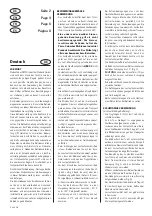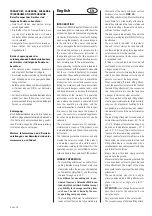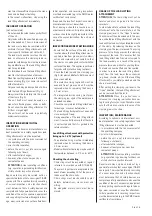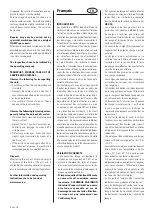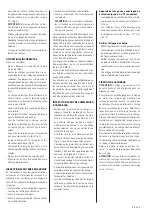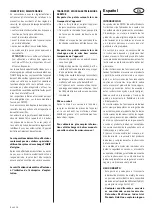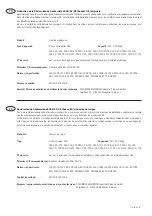
4 von 16
English
INTRODUCTION
Products of CMCO Industrial Products GmbH
have been built in accordance with the state-
of-the-art and generally accepted engineering
standards. Nonetheless, incorrect handling
when using the products may cause dangers
to life and limb of the user or third parties
and/or damage to the hoist or other property.
The operating company is responsible for
the proper and professional instruction of
the operating personnel. For this purpose, all
operators must read these operating instruc-
tions carefully prior to the initial operation.
These operating instructions are intended to
acquaint the user with the product and enable
him to use it to the full extent of its intended
capabilities. The operating instructions contain
important information on how to operate the
product in a safe, correct and economic way.
Acting in accordance with these instructions
helps to avoid dangers, reduce repair costs
and downtimes and to increase the reliability
and lifetime of the product. The operating
instructions must always be available at the
place where the product is operated. Apart
from the operating instructions and the
accident prevention act valid for the respec-
tive country and area where the product is
used, the commonly accepted regulations
for safe and professional work must also be
adhered to.
The personnel responsible for operation,
maintenance or repair of the product must
read, understand and follow these operating
instructions.
The indicated protective measures will only
provide the necessary safety, if the product
is operated correctly and installed and/or
maintained according to the instructions. The
operating company is committed to ensure
safe and trouble-free operation of the product.
CORRECT OPERATION
- The load lifting attachment is used for trans-
porting individual upright sheet metal and
steel plates within the jaw capacity indicated
on the identity plate (Tab. 1) and for rotating
the load through up to 180°.
- Any diff erent or exceeding use is con-
sidered incorrect. Columbus McKinnon
Industrial Products GmbH will not accept
any liability for damage resulting from
such use. The risk is borne by the user
or operating company alone.
- The load lifting attachment is suitable for all
loads of steel that can be fully entered into
EN
the mouth of the clamp and have a surface
hardness of up to max.
HRC 30
.
- Load lifting attachments with protective lining
are suitable for a wide variety of loads pro-
vided they withstand the forces introduced
via the load lifting attachment and have a
suffi
cient surface roughness.
- The load capacity indicated on the unit is the
maximum working load limit (WLL) that may
be attached.
- The min. load is indicated on the side of
the unit. It must always be complied with,
as otherwise the clamping force required for
safe transport will not be reached.
- Do not allow personnel to stay or pass under
a suspended load.
- A lifted or clamped load must not be left
unattended or remain lifted or clamped for
a longer period of time.
- The operator may start moving the load only
after it has been attached correctly and all
persons are clear of the danger zone.
- When suspending the load lifting attach-
ment, the operator must ensure that neither
the load lifting attachment, the suspension
(e.g. hook, shackle, etc.) nor the load pose
a danger to himself or other personnel.
- Prior to operation of the load lifting attach-
ment in special atmospheres (high humidity,
salty, caustic, alkaline) or handling hazard-
ous goods (e.g. molten compounds, radioac-
tive materials) consult the manufacturer for
advice.
- The load lifting attachment may be used at
ambient temperatures between –40° C and
+100° C. Models with protective lining may
be used at temperatures between –20° C
and +60° C. Consult the manufacturer in
the case of extreme working conditions.
- If longer sheets of metal or profi les are to be
transported, we recommend that two load
lifting attachments in combination with a
spreader beam be used to prevent load sway
and lateral tensile forces.
- Always transport the load slowly, carefully
and close to the ground.
- Make sure that when depositing the load, the
crane hook does not press against the load
lifting attachment. The weight of the crane
hook could lead to opening of the load lifting
attachment.
- The round section steel chain in appro-
priately equipped load lifting attachments
allows side pull at an angle of up to 30°
(Fig. 3).
ATTENTION:
Load lifting attachments with
Flyer chain must not be subjected to side
pull at an angle.
- Only use crane hooks with a safety latch.
- The suspension eye of the load lifting attach-
TRANSPORT, LAGERUNG, AUSSERBE-
TRIEBNAHME UND ENTSORGUNG
Beim Transport des Gerätes sind
folgende Punkte zu beachten:
• Gerät nicht stürzen oder werfen, immer
vorsichtig absetzen.
• Die Kette ist so zu transportieren, dass
sie sich nicht verknoten kann, sich keine
Schlaufen bilden können und sie sich nicht
in sich verdreht.
• Geeignete Transportmittel verwenden.
Diese richten sich nach den örtlichen
Gegebenheiten.
Bei der Lagerung oder der
vorübergehenden Außerbetriebnahme
des Gerätes sind folgende Punkte zu
beachten:
• Das Gerät an einem sauberen, trockenen
und möglichst frostfreien Ort lagern.
• Das Gerät vor Verschmutzung, Feuchtigkeit
und Schäden durch eine geeignete Abde-
ckung schützen.
• Aufhängeösen, Haken und Anschlagkette(n)
mit einem dünnen Ölfi lm vor Korrosion
schützen.
• Soll das Gerät nach der Außerbetriebnahme
wieder zum Einsatz kommen, ist es zuvor
einer erneuten Prüfung durch eine befähigte
Person zu unterziehen.
Entsorgung:
Nach Außerbetriebnahme sind die Teile des
Gerätes und gegebenenfalls die Betriebsstoff e
(Öle, Fette, etc.) entsprechend den gesetzli-
chen Bestimmungen der Wiederverwertung
zuzuführen bzw. zu entsorgen.
Weitere Informationen und Betriebs-
anleitungen zum Download sind unter
www.cmco.eu zu fi nden!
Summary of Contents for TIGRIP TAG
Page 13: ...13 von 16...


